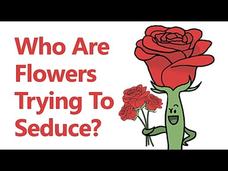Amoeba Sisters
Plant Reproduction in Angiosperms
A colony of bees has moved into someone's home and the owners know how important bees are for pollination. Should they keep the bees? An informative video also includes a guide to plant reproduction including the male and female parts,...
Crash Course
The Plants and the Bees: Plant Reproduction
This video explains the difference between gametophytes and sporophytes and uses this this information to teach the reproduction process of various vascular plants. Viewers see how ferns, gymnosperms, and angiosperms reproduce.
Curated OER
Plant Reproduction: Asexual Reproduction
Asexual reproduction in plants occurs from bulbs, perennating organs, or even gardening techniques like cuttings. Commercial growers rely on the ability of some plants to reproduce asexually and grow roots rather than starting from...
Amoeba Sisters
Asexual and Sexual Reproduction
Why do some organisms reproduce sexually, others reproduce asexually, and some both? Biology scholars examine the pros and cons of sexual and asexual reproduction through a short, informative video. The resource offers great examples of...
Curated OER
Life Cycle of a Flowering Plant
The development of the male and female gametes in a plant is illustrated, explaining plant fertilization, pollination, and reproduction. Overall, get a complete picture of the life cycle of a flowering plant with some wonderful details...
Curated OER
STEMbite: Seed Dispersal
Dandelion and maple tree seeds are blown and thrown to show two methods of seed dispersal. The narrator videotapes from his vantage point, his hands visible, but never his face. He examines helicopter blades as a human imitation of maple...
PBS
Seasonal Science: Pine Pollen
More than 125 species of pine trees exist, and each species can live over 100 years, with some living over 1,000 years—that's a lot of pine pollen! The Seasonal Science series explains why pine trees produce pollen. The video details the...
Scholastic
Study Jams! Flowers
RJ hangs out in Zoe's garden as she explains pollination, flower anatomy, and fertilization. This cartoon-styled feature is sure to stay in your botanists' minds! Follow it with the dissection of large flowers, such as the lily.
PBS
How Sex Became a Thing
Birds, bees, flowers, trees ... and Funisia dorothea? Biology scholars journey back in time to discover more about the history of sexual reproduction. The video, one of many in a biology playlist, covers our earliest eukaryotic ancestor,...
MinuteEarth
Who Are Flowers Trying to Seduce?
Learn the tricks plants use to attract insects and animals in their quest for pollination. A thorough video lesson describes plant adaptations that meet their reproductive needs. From bees to rodents to bats, the narrator describes how...
Crash Course
The Sex Lives of Nonvascular Plants: Alternation of Generations
Plants evolved more than 400 million years ago into two types — vascular and nonvascular. Here's a video that explains the difference between vascular and nonvascular plants and then focuses on the over 24,000 types of nonvascular...
Curated OER
Pollination, Plants and Insects
The pollination of milkweed involves a high risk for the bees and butterflies involved. Though the nectar is sweet and delicious, the pollen is very sticky. If a bee is not strong enough to pull the pollen free, he will be stuck and die....
TED-Ed
The Sexual Deception of Orchids
A plant engaged in sexual deception? Strange but true. Believe it or not, orchids have developed a range of sexual adaptations that permit them to attract pollinators. The narrator of a short video describes a variety of strategies used...
Deep Look
The Sex Lives of Christmas Trees
Coniferous trees produce both male and female pine cones. The video explains the differences, how these trees reproduce, and why it is beneficial. It includes facts about the location, size, and age of pine trees.
Deep Look
This Vibrating Bumblebee Unlocks a Flower's Hidden Treasure
Some plants lock their pollen up until feeling the correct password. The video explains buzz pollination and how it differs from the pollination of other types of flowering plants. It lists multiple plants that require it and...
California Academy of Science
Why Protect Pollinators?
Would you rather having biting flies or chocolate? The question may seem absurd, but cocoa trees rely on pollination from biting flies. Viewers come to understand the importance of pollinators to our food supply, flowers, and entire...
Crash Course
Vascular Plants = Winning!
Viewers explore vascular plants with a video that shows their different tissues, their ability to grow taller and wider, and their parts. Young scientists then see these plants xylem and phloem and learn how vascular plants move water...
Other popular searches
- Flowering Plant Reproduction
- Seedless Plant Reproduction
- Asexual Plant Reproduction
- Plant Reproduction Lab
- Plant Reproduction by Seeds
- Plant Reproduction Video
- Types of Plant Reproduction
- Plant Reproduction Parts
- Plant Reproduction Puzzles
- Plant Reproduction Do Now
- Sexual Plant Reproduction
- Plant Reproduction by Spores


















